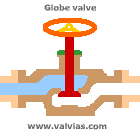Valves can be classified by:
The operative of the valve closure member
The kind of closure member movement defines both the geometry and operative of the valve.

•
Multi-turn valve (linear motion valves):
The closure member has a linear displacement generally by turning its threaded stem several times.
This operation is slow, but it gives accuracy and stability to position the closure member, which is necessary in some control valves.
Types of valves: Gate valve, Globe valve, Fixed cone valve, Needle valve and Pinch valve.

•
Quarter-turn valve (rotary valve):
The closure member as well its shaft turn 0║-90║; from the fully-open
position to the fully-closed position.
They are quick opening/closure valves.
Types of valves: Ball valve, Butterfly valve, Plug valve, Spherical valve.
The functionality of the valve
• Control: pressure / flow rate regulation.
• Closure at over-speed flow. (i.e. immediate closure if downstream pipeline is broken by accident).
• Overpressure protection.
• Back flow prevention (
check valve).
• On/Off service.
The nature and physical conditions of the flow
• Low/High temperatures.
• Low/High pressures.
• Cavitation risk.
• Corrosive or erosive properties of the flow.
• Viscosity: Gas, liquid, solid.
• Hygiene requirements (for the food or pharmacy industry...).
• Explosion and risk of inflammability (chemical, petrochemical industry).
Other forms of valve classification
• Admissible leakage level.
• Connection to the pipe.
• An unique direction of the flow or bidirectional flow.
• Number of ports: most of the valves have two port, named inlet and outlet port.
But for same applications there are multi-port configured valves. They can be three-way and four-way valves.
• Angle between the inlet and outlet port of the valve.
